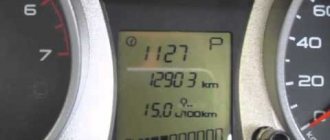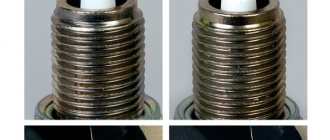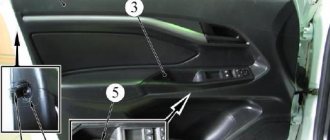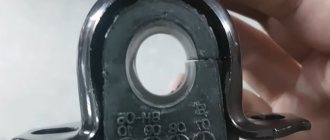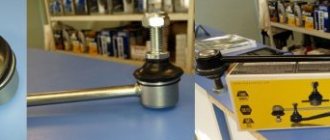The advanced VAZ Sport Wagon entered production in the second half of 2021. Versions of Cross in station wagon and sedan bodies - a little later. The models are positioned as off-road vehicles. This is indicated by a voluminous plastic body kit designed to protect the paintwork all around from scratches. The models are more likely to follow the SUV fashion, rather than really pretend to conquer the tough “intersection”. There is no all-wheel drive. There is also no electronics that could apply the brakes to simulate a 4x4.
Ground clearance Lada Vesta
Ground clearance is measured as the distance between the lowest point of the car body and the road surface. For Russian off-road use, the large clearance of AVTOVAZ vehicles is a definite plus and is 178 mm for the standard Lada Vesta. And this is not the limit: vehicles with increased cross-country ability have been created.
Lada Vesta SW Cross
This off-road station wagon is best used in difficult road and climatic conditions and on rough terrain. Powerful, tall, it is provided with increased ground clearance and a plastic body kit around the perimeter at the bottom. The ground clearance of the Lada Vesta SV Cross is 203 mm recorded in the car’s passport. Lada Vesta SW Cross surpasses its predecessors in cross-country ability, endurance, stability, behaves well in high-speed travel, and provides a comfortable rest.
Increased ground clearance of Lada Vesta SV Cross. Source: avtospravochnaya.com
The appearance of the car and the interior design attract attention and are another plus.
Ground clearance of Vesta sedan
According to the factory specifications, the clearance of the Vesta sedan is 178 mm: this is significantly less than in the Cross version, but more than that of the corresponding foreign competitors. The price of a Russian car is more affordable. At full load, the ground clearance of the Vesta sedan is reduced in the engine crankcase area to 170 mm, its minimum value under the mudguard is 145 mm.
Ground clearance of Lada Vesta with CVT
Mass production of the Lada Vesta with a CVT (automatic continuously variable transmission) began in 2021. The model has undergone an update of the interior and appearance (from Vesta Sport the Exclusive package received elements of the ceiling trim and fittings), received a new transmission and Renault-Nissan engine. The appearance of the variator ended the era of the “robot”, and the new Vesta automatic should become a hit on the Russian car market.
According to marketers, cars with an AMT robot were chosen by no more than 9% of Vesta buyers, and with the advent of versions with a CVT, this percentage is planned to increase to 30.
According to the manufacturer, Vesta’s ground clearance has not changed. This is explained by the fact that the variator is installed below the Renault type (sedan, station wagon - 7 mm, cross versions - 4 mm). The producers are proud of their achievement, but they may be a little understated. The available standard protection reduces the ground clearance by ten millimeters, and the variator is located even lower than the crankcase.
Then the real clearance for the versions will be as follows:
| Body | ||||
| S.E. | SE Cross | S.W. | SW Cross | |
| Ground clearance, mm | 144 | 170 | 144 | 170 |
What is the ground clearance of the Lada Vesta SV Cross station wagon in comparison with its opponents
The charged five-door in stock is painted in Glacier color, which in transcription means white.
Spectacular “Mars”, or in our opinion, rich orange, which off-road versions flaunt on the covers of magazines and booklets - an option for 12,000 rubles above. The 17-wheels, which sincerely hint at a road bent, belong exclusively to these versions. The exhaust tips are here. There are no cut corners on the bumpers - exclusively crossover styling. What has really been done is the ground clearance has been increased. In the technical specifications, the ground clearance of the Lada Vesta Cross is indicated as a maximum value of 203 mm. The civilian version is 25 mm lower – 178 mm. The same parameter applies to the Lada Vesta SW Cross station wagon, and it is honest – between the crankcase protection and the base on which the wheels stand. The current layout was achieved by installing other shock absorbers and springs.
Let's take a look at the situation among opponents in the niche. According to technical data, the distance between the body and the supporting surface is:
- Kia Rio X-Line: 170 mm.
- Renault Captur: 204 mm.
- Hyundai Creta: 190 mm.
- Lada Xray: 195 mm.
Cross versions are not in last place. The comparison shows that the sedan and station wagon are capable of competing even with front-wheel drive potential SUVs - Creta and Capture.
Is it possible to increase Vesta's ground clearance, how?
A small re-equipment can help improve the cross-country ability of the Lada Vesta. In this case, the ground clearance of Vesta SW Cross needs to be increased only by the available amount. Intervention in the car's suspension will definitely lead to a change in its handling. Shock absorbers, drive shafts, their angles during operation, CV joints, calculation of loads when driving with obstacles are developed at a nominal ground clearance, and changing it will not be painless, because:
- The aerodynamic properties will change, drag, noise levels, and fuel consumption will increase.
- The center of gravity will rise, stability and controllability in corners will deteriorate. The load on the suspension will increase.
- Increasing the ground clearance by wheel size will cause the speedometer, odometer, ABS and ESP to work incorrectly.
- The service life of CV joints will decrease, the change from the calculated angle of operation, bending angles, turns, which will negatively affect the hinges, stabilizer bushings, and support bearings.
- Significant changes are also taking place in the operating mode of the suspension, which must adapt to new conditions. To achieve the maximum travel of the stock shock absorbers (front - 157 mm, rear - 169 mm), you will need to lengthen the rod. In the case of a critical load, the working amplitude increases and the stand may break out of the glass.
In order to minimize undesirable effects on the characteristics with increased clearance above the ground, it is necessary to lift it correctly, no more than 20-30 mm.
Increasing ground clearance in known ways makes adjustments to the efficiency of the suspension:
- Installation of larger wheels with higher profile tires. If you install 195/60/R16 instead of 195/55/R16 tires, this will increase the ground clearance by 5 mm. You can install larger wheels with the same tires, for example, 195/55/R17, which will increase the ground clearance by 12 mm. If you increase the wheels and tires, for example, 195/60/R17, then the lift of the car will be almost 2 cm. However, such actions will increase the load on the wheel bearings.
- The use of spacers for shock absorbers (metal, polyurethane, rubber) disrupts the toe angle of the wheels and reduces the service life of the CV joint.
- Replacing or increasing the rigidity of standard springs (by using intercoil attachments, buffers) sharply reduces their service life.
Spare parts, accessories, tuning elements and additional equipment are offered by Vesta Shop.
Vesta factory tires and wheels
If you decide to replace the standard wheels and tires on a Lada Vesta, then rely on the full diameter of the wheel. How to do this, using 185/60 R14 as an example:
- A disk with a diameter of 14″ is equal to 14 * 25.4 (1 inch = 2.54 cm) = 355.6 mm.
- The height of the tire profile is calculated as follows: 185*60/100=111 mm. Add up the rim diameter and the two tire profile heights: 355.6 111 * 2 = 577.6 mm.
The green color indicates the minimum deviation of the wheel diameter (up to 3 mm); Orange indicates a diameter deviation from 3 to 6 mm.
When installing tires or wheels that differ in parameters from those recommended by the factory, you can:
- be refused warranty repair of the chassis;
- be stopped by a traffic police inspector, who has the right to draw up a report on the car’s non-compliance with the requirements of the Technical Regulations;
- fail to pass technical inspection.
| Increasing disc diameter | Increasing rim width | Increasing tire width | |
| Car style | will improve | will improve | will improve |
| Road holding | will improve | will improve | will improve |
| Steering precision | will improve | will improve | will improve |
| Tire grip | Will not change | Will not change | will improve, but only on dry roads |
| Resistance to hydroplaning | Will not change | Will not change | will get worse |
| Comfort on rough roads | will get worse | Will not change | will improve |
| Road noise | Will not change | Will not change | will intensify |
| Gasoline consumption | Will not change | will increase | will increase |
| Tire wear | Will not change | Will not change | will increase |
If you are going to buy winter tires for your Lada Vesta, then try to choose narrower tires. These tires will create more pressure on the road surface and improve traction. Remember that wide tires are more sensitive to ruts in winter. And low-profile tires make the ride less comfortable, because... transfer even the smallest holes to the body.
The smaller the unsprung mass (this includes the mass of tires and wheels), the better the car will hold the road and accelerate faster. For example, if you put wheels on a car that are 2 kg lighter each, then acceleration to 100 km/h will be reduced by 0.2 seconds.
What wheels and tires did you choose for the Lada Vesta? What are the pros and cons of such a replacement? Participate in the survey, leave feedback and ask questions. Let us remind you that in this article we determine the real fuel consumption of this car.
Is it possible to reduce clearance
The desire to reduce the ground clearance of the Lada Vesta SV Cross is not entirely clear. This car is purchased for difficult driving conditions. The owner usually reduces the ground clearance of a Lada not to improve technical characteristics, but to satisfy his own ambitions and beautiful photos. A certain part of car enthusiasts have their own opinion about the beauty and brutal appearance of the vehicle. They prefer down-to-earth cars that literally drag their bellies along the asphalt.
They reduce the ground clearance in two ways: they cut the springs with their own hands or purchase shorter ones - Technospring -50 mm or -30 mm.
In the first case, the financial costs will be minimal, but you need to work, in the second you will have to spend money.
If stiffer lowering springs are installed, lowering the ride height has certain advantages:
- Handling and stability at high speed are improved by increasing suspension rigidity.
- Sharper steering and lack of roll allow you to take turns at higher speeds.
- The car does not “bite” during sudden braking or stopping.
- Reducing resistance reduces fuel consumption (up to 0.5 liters per 100 km).
What are the negative reviews associated with:
- When driving over bumps and bumps, you will have to slow down, increase your vigilance, and be careful not to damage the front bumper and underbody.
- There is a risk of damage to the lower part of the doors on the curb when opening in a parking lot.
- Outside the city, on country roads, you will have to carefully choose a suitable route. In many areas of the lowered Lada Vesta, the passage may be completely closed.
- On a snowy road, the front bumper can turn into a snow bucket. Narrow arches will promote snow accumulation.
For some, a reduction is truly a measure that significantly improves technical characteristics and allows you to correct the manufacturer’s shortcomings. For others, the disadvantages that arise when reducing ground clearance are unacceptable.
↑ At full load
The concept of full load implies that the car contains a driver, passengers, and cargo. The sedan can withstand a maximum load of 400 kilograms. This is also reflected at a distance to the surface of the earth. It was already said above that when the car is fully loaded, its value will be 14.4 or 17.1 cm, depending on the location of measurement. It is important to understand that the real ground clearance of the Lada Vesta depends on exactly how loaded the car is. If there is a driver and a passenger in the car, but there is no cargo, then the ground clearance will differ from the declared one.
Clearance of closest competitors
In the AvtoVAZ car lineup, the Lada Vesta is superior in ground clearance to all models except all-wheel drive. Of the foreign competitors of this class, the closest is Nissan Almera (160 mm). Further we can note: Kia Cee'd (150 mm), BMW 3 Series F30 (140 mm), Audi A1 Sportback (125 mm). A higher class car, the Peugeot 408, has a record height of 178 mm.
The consumer market did not immediately accept the Lada Vesta, but with the creation of the SW and SW Cross family station wagons, the car’s position strengthened significantly. And the ground clearance of the Lada Vesta SW Cross is such that crossovers can be envious.
Zhezhora › Blog › Lada Vesta SW Cross: a traveler’s dream or a banal marketing ploy?
Oh, these modern trends in the automotive industry... We take a more or less popular car, slightly work with the suspension towards a slight increase in ground clearance, install larger wheels, sculpt a bunch of plastic linings and... voila! The modification for outdoor enthusiasts is ready! And everything seems great, but after a couple of months of operation, when post-purchase euphoria gives way to sober value judgments, a very pertinent question begins to loom in the owners’ heads: “Do I really need this particular car? Or did I get carried away with my choice, buying into advertising gimmicks?”
Lada Vesta is the flagship model of AvtoVAZ. Not only did it generate an unprecedented amount of hype for the Russian auto industry at the start (of course, it was its own development, capable of seriously competing with “foreign” products of a similar class), but during its operation it also received fairly high ratings from car owners. Even talkative bloggers, scattered with comments with or without reason, for the most part admitted that if the car cannot be called excellent, then at least it fully justifies its price.
Of course, many were waiting for Vesta in a station wagon. And Vesta in the “Cross” modification was literally waited for with bated breath. Formally, we waited. However, the queues for these cars are so long that in practice, potential owners will not soon enjoy the delights of using the new product. And so that the wait doesn’t seem so long and painful, it’s time to talk about the pros and cons of VAZ’s next brainchild
↑ Car behavior on the road
The sufficient height of the car will definitely be appreciated by motorists living in provincial settlements. This is where severe road problems are usually observed. The high ground clearance of the Lada Vesta from AvtoVAZ allows you to minimize the risk of problems associated with this. But the long distance to the bottom also has disadvantages. It negatively affects the vehicle's handling and maneuverability while driving.
Car manufacturers have tried to reduce the negative consequences of high ground clearance. The vehicle has good steering, thanks to which the car behaves well on the road. The reduction in maneuverability is almost imperceptible.
The suspension on the car has also been carefully planned and designed. It rests on the body through a subframe. Thanks to this state of affairs, Vesta has good driving characteristics. Some compare it with foreign cars, and Lada will even give many foreign cars a head start in terms of characteristics. For example, the Nissan Almera has a height to the bottom of 165 mm. The Peugeot 408 has a ground clearance of 178 mm to the crankcase.
If we compare the parameters of Vesta with domestic analogues, then the ground clearance indicator exceeds the characteristics of other models from AvtoVAZ. There are only two cars that have slightly more ground clearance. We are talking about Kalina 2 and Largus with front-wheel drive. This is why Lada Vesta is so popular today. It is liked by drivers who drive a lot on roads that are not of very good quality.
In a word, the ground clearance of the mentioned sedan is a fairly pleasant indicator for drivers. Even at full load the machine remains quite high. This allows you to drive on uneven roads and even overcome all kinds of obstacles without any problems.
It is important to understand that if the load is incomplete, the clearance value will differ from that stated in the documents. If you wish, you can take measurements yourself
Does the 1.8 Lada Vesta Cross engine bend valves when the timing belt breaks?
Lada Vesta SV Cross what color to choose
The answer is yes! The 1.8 Lada Vesta Cross SV engine with index 21179 bends the valve when the timing belt breaks. This is a characteristic feature of any modern engine. The thing is that modern cars are trying to squeeze out maximum power without increasing engine size. This is done by lightening the connecting rod and piston group, as well as increasing the compression ratio. In this case, it is impossible to make grooves in the pistons so that if the timing belt breaks, they do not meet the valves. Therefore, if the pump, tension roller jams, or simply breaks the belt, a major engine overhaul is inevitable.
Many people are probably wondering what parts were used to assemble the 21179 motor. Now we’ll talk about this.
1. Timing belt - Continental. Manufacturers claim that the belt life is about 180 thousand km. I doubt that this is real, but these are the stated figures. Read it yourself here. 2. Injectors - Continental. These injectors have a longer service life than the Priora and also have increased productivity. 3. Valves - Mahle. 4. Pump - GMB. The resource is the same as that of the timing belt - 180 thousand km. 5. Oil pump - GMB. Has improved performance. 6. Camshafts - Toyota Tsusho. The decision to use these RVs was due to the fact that the old cast iron RVs were heavier than Toyota ones. 7. INA phase adjustment mechanism.
Features of the 1.8 engine Lada Vesta SV Cross 2017
Externally, the 21179 engine is very similar to other 16-valve VAZ and . But it was possible to achieve a volume of 1.8 liters not thanks to an increase in the diameter of the cylinders, but to an increase in the piston stroke in a standard cylinder. To do this, it was necessary to rework the entire connecting rod and piston group, and also install a new crankshaft.
In addition, 21179 is the first VAZ engine to use variable valve timing.
The 1.8 Vesta engine also differs from previous versions in that it has completely redesigned oil and cooling channels.
Due to the increase in engine volume, it was necessary to install new injectors with higher performance, an enlarged throttle valve, and also increase the volume of oil in the engine. The oil pan now holds 4.4 liters of engine oil, and a more efficient oil pump is located under the crankcase. The intake ports are also larger than before.
Another characteristic feature of the 21179 engine was the abandonment of the classic model of using a mass air flow sensor. Now readings are taken using an absolute pressure sensor and an air temperature sensor.
The graph clearly shows that the developers did a very good job tuning the 21179 engine. Already at 4 thousand rpm, the 179 engine produces a maximum torque of 170 Nm, and at 5.5 thousand rpm it produces a maximum power of 122 hp. With.


